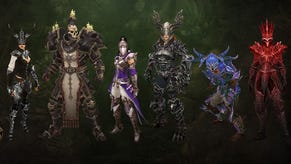Performance Analysis: Diablo 3 at 1080p on Xbox One
Full HD confirmed, but what about the locked 60fps?
We were hoping to bring you a full Face-Off for Diablo 3 on Xbox One and PlayStation 4 in time for today's launch, but the definitive word on Blizzard's latest console release will have to wait owing to game-changing day one patches deployed for both consoles.
As promised, Xbox One sees a boost to resolution from 900p to full 1080p, while updates for both systems address a bizarre dual frame-rate bug we uncovered last week that the developer has pledged to fix.
Xbox One saw this 1080p patch released yesterday, allowing us to bring you this quick update. We were initially disappointed to see that while the PS4 version was also subject to a new patch, the same dual frame-rate issue was still in effect, albeit to a lesser degree. However, upon testing, the PS4 discretely updated again to C2.0.9.26396 later that day, with the patch notes listing "improved gameplay performance throughout title" - and yes, a quick test in the problem area outside the New Tristram gates reveals the issue has been resolved. Further testing still needs to be carried out in the game's more packed areas, but so far, the PS4's render-side stuttering looks to be fully fixed.
The remaining question concerns Xbox One and how Blizzard can raise Diablo 3's resolution from 900p to 1080p without impacting performance. During our conversation last week at Gamescom with Blizzard's John Hight, the production director revealed that the game was initially running at full HD, though this resolution was lowered in order to nail a consistently high performance.
"We did have 1080p, but we were finding it challenging to keep our frame-rate. Because Diablo's so much of an action game, we wanted to have a responsive feel - especially with four players. When you get four witch doctors in a room full of demons, that's probably the worst case scenario for us because we have effects going off everywhere. We want to make sure that it still feels very glassy, very responsive, and that's why we dropped resolution down on it," he explained.

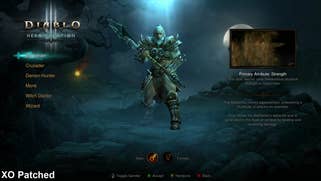

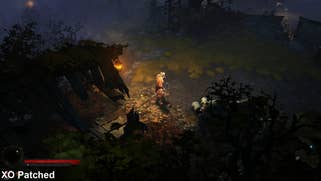

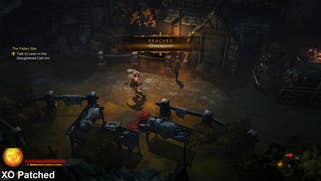
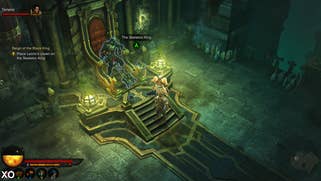

"We did find it challenging early on to get it to 1080p. That's why we made the decision to drop to 900. That's what we demoed and were showing around E3 time. And Microsoft was just like, 'This is unacceptable. You need to figure out a way to get a better resolution.' So we worked with them directly, they gave us a code update to let us get to full 1080p."
The good news is that Blizzard has indeed achieved a full 1080p resolution on Xbox One, and has done so with no impact to visual quality. This is aside from what we suspect may be some light tweakery to the shadow maps, an occasional, subtle change that takes effect on the updated PlayStation 4 build too. From an image quality perspective, though, first impressions suggest the two console versions are now absolutely identical - a point we hope to elaborate on once we dissect a greater breadth of areas for the full comparison.
So far, so good. However, in terms of pure pixel throughput we are still looking at a challenging 44 per cent rise in resolution on Xbox One between the initial build and the results of the new patch. The code update John Hight refers to - presumably the XDK revision that returns the Kinect reservation to games - gives an additional 10 per cent of GPU power back to developers. While welcome, it seems unlikely that this update alone can deliver the ability to drive so many more pixels. And in fact, it's clear the rise from 900p to 1080p has come at a cost; our performance analysis of the revised Xbox One code shows drops down from 60fps in busy areas.
Firstly, it should be pointed out that these are the "standard" frame-rate drops we're accustomed to when it comes to analysing games, and not the dual refresh issue we noted in our previous article. We actually went through 12,000 frames of footage per platform by hand in order to highlight the issue, but in this case, our standard programmatic approach worked just fine in isolating the frame-rate drops in the 1080p patched version.
The cause and effect is fairly straightforward. In areas with more enemies and effects - like the Tristram gates battle, or chaotic Act Two overground encounters - we now see frame-rates drop from the locked 60fps seen at 900p to the low 50s. In short, while Blizzard closes the gap between Xbox One and PlayStation 4 in terms of image quality, there are now performance issues that creep in at the game's extremes while at 1080p. They're not game-breaking, and many players may not even notice - but it's clear that a 44 per cent boost to resolution doesn't come for free: in the same scenarios, the 900p version proved smoother.
All of which opens up an interesting debate on frame-rate versus pixel-count. Hight's comments at Gamescom last week, along with reports that Microsoft sent engineers to Bungie to aid in pushing Destiny to 1080p, suggest that the platform holder is keen on reducing resolution differences in multi-platform games where possible. But if frame-rate takes a hit as a consequence, is this necessarily the best course of action?
As we reported last week, Diablo 3 running at 900p on Xbox One may not boast the same, granular level of sharpness as its PS4 counterpart, but the difference is very subtle. It's a difficult one to call given that the patched Xbox One frame-rate dips don't make Diablo 3 any less enjoyable either. But for a game of Diablo 3's action-focused design - and having played both iterations - we would probably take the locked 60fps at 900p over the less consistent 1080p, given the choice.
We'll report back with a more detailed take on the two console versions, stacked up against the PC original, later on in the week.








